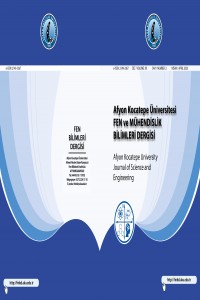Abstract
In the production of digital models belonging to the earth, LiDAR technology stands out with its great advantages in terms of labor, time and accuracy compared to traditional methods. Processing LiDAR data consisting of an irregular point cloud is an important process for the numerical models we will create. In this process, filtering of raw LiDAR data is an important step. In open source and commercial softwares, there are many different filtering algorithms that determine ground points by filtering LiDAR data. When the studies are examined, the strengths and weaknesses of each algorithm stand out for different land surfaces. Each algorithm has different parameters in its content. In this study, the performance of the CSF (Cloth simulation filter) algorithm, which is available in an open source software that can be easily downloaded by the users for a challenging terrain surface consisting of dense forests and steep slopes, was tested. As a result of filtering with different parameter values, it has been revealed that the grid resolution parameter in the CSF algorithm is important in determining the ground point and determines more ground points with low values for a steep and inclined working area. In addition, when the field models produced as a result of filtering are examined, it is concluded that manual filtering is required for the objects that cannot be removed.
References
- Doğruluk M., Aydın C., Yanalak M., 2018. Kırsal Alanlarda SYM Üretiminde Filtreleme Yöntemlerinin Performans Analizi: Hava LİDAR Uygulaması; İstanbul Örneği”. Geomatik Dergisi, 3(3); 242-253
- Meng, X., Nate C., and Kaiguang Z.,. 2010. Ground filtering algorithms for airborne LiDAR data: A review of critical issues. Remote Sensing 2.3 (2010): 833-860.
- Soycan, M., Tunalıo, N., and Öcalan, T., 2011. Three dimensional modeling of a forested area using an airborne light detection and ranging method. 581–595.
- Süleymanoğlu B, , Soycan M., 2017. Hava Lidar Verilerinde Kullanılan Filtreleme Algoritmalarının İncelenmesi" TMMOB Harita ve Kadastro Mühendisleri Odası, 16. Türkiye Harita Bilimsel ve Teknik Kurultayı, 3-6 Mayıs, Ankara.
- Sulaiman, N. S., Majid, Z., & Setan, H., 2010. DTM generation from LiDAR data by using different filters in open–source software. Geoinformation Science Journal, 10(2), 89-109.
- Süleymanoğlu, B., 2016. Lidar tekniği ile elde edilen nokta bulutların sınıflandırılması ve filtreleme algoritmalarının incelenmesi, Yüksek Lisans Tezi, Yıldız Teknik Üniversitesi, İstanbul, Türkiye
- Varlık A., Uray F., 2017. Üçgenleme ve enterpolasyon temelli lidar filtreleme algoritmalarının performans analizi. AKÜ FEMÜBİD 17 (2017) Özel Sayı (156-165)
- Zhang, W., Qi, J., Wan, P., Wang, H., Xie, D., Wang, X., & Yan, G., 2016. An easy-to-use airborne LiDAR data filtering method based on cloth simulation. Remote Sensing, 8(6), 501.
Abstract
Yeryüzüne ait sayısal modellerin üretilmesinde LiDAR teknolojisi geleneksel yöntemler ile kıyaslandığında emek, zaman ve doğruluk açısından büyük avantajları ile ön plana çıkmaktadır. Düzensiz bir nokta bulutu topluluğundan oluşan LiDAR verilerini işlemek oluşturacağımız sayısal modeller için önemli bir süreçtir. Bu süreç içinde, ham LiDAR verilerinin filtrelenmesi önemli aşamalardandır. LiDAR verilerini filtreleyerek zemin noktalarını belirleyen açık kaynak kodlu ve ticari yazılımlarda birçok farklı filtreleme algoritmaları vardır. Yapılan çalışmalar incelediğinde her algoritmanın farklı arazi yüzeyleri için güçlü ve zayıf yönleri öne çıkmaktadır. Her algoritma içeriğinde farklı parametreleri barındırır. Bu çalışmada büyük çoğunluğunun sık ormanlık alanlardan ve dik yamaçlardan oluşan zorlu bir arazi yüzeyi için açık kaynak kodlu bir yazılımda bulunan CSF (Cloth simulation filter) algoritmasının zemin noktalarını filtrelemedeki performansı test edilmiştir. Farklı parametre değerleri ile yapılan filtrelemeler sonucunda CSF algoritmasındaki grid çözünürlüğü parametresinin zemin noktası belirlemede önemli olduğu, dik ve eğimli bir çalışma alanı için düşük değerlerle daha fazla zemin noktası belirlediği ortaya çıkmıştır. Ayrıca filtreleme sonucu üretilen arazi modelleri incelendiğinde kaldırılamayan objeler için manuel filtreleme gerekliliği sonucuna varılmıştır.
References
- Doğruluk M., Aydın C., Yanalak M., 2018. Kırsal Alanlarda SYM Üretiminde Filtreleme Yöntemlerinin Performans Analizi: Hava LİDAR Uygulaması; İstanbul Örneği”. Geomatik Dergisi, 3(3); 242-253
- Meng, X., Nate C., and Kaiguang Z.,. 2010. Ground filtering algorithms for airborne LiDAR data: A review of critical issues. Remote Sensing 2.3 (2010): 833-860.
- Soycan, M., Tunalıo, N., and Öcalan, T., 2011. Three dimensional modeling of a forested area using an airborne light detection and ranging method. 581–595.
- Süleymanoğlu B, , Soycan M., 2017. Hava Lidar Verilerinde Kullanılan Filtreleme Algoritmalarının İncelenmesi" TMMOB Harita ve Kadastro Mühendisleri Odası, 16. Türkiye Harita Bilimsel ve Teknik Kurultayı, 3-6 Mayıs, Ankara.
- Sulaiman, N. S., Majid, Z., & Setan, H., 2010. DTM generation from LiDAR data by using different filters in open–source software. Geoinformation Science Journal, 10(2), 89-109.
- Süleymanoğlu, B., 2016. Lidar tekniği ile elde edilen nokta bulutların sınıflandırılması ve filtreleme algoritmalarının incelenmesi, Yüksek Lisans Tezi, Yıldız Teknik Üniversitesi, İstanbul, Türkiye
- Varlık A., Uray F., 2017. Üçgenleme ve enterpolasyon temelli lidar filtreleme algoritmalarının performans analizi. AKÜ FEMÜBİD 17 (2017) Özel Sayı (156-165)
- Zhang, W., Qi, J., Wan, P., Wang, H., Xie, D., Wang, X., & Yan, G., 2016. An easy-to-use airborne LiDAR data filtering method based on cloth simulation. Remote Sensing, 8(6), 501.
Details
| Primary Language | Turkish |
|---|---|
| Subjects | Engineering |
| Journal Section | Articles |
| Authors | |
| Publication Date | May 20, 2020 |
| Submission Date | December 17, 2019 |
| Published in Issue | Year 2020 Volume: 20 Issue: 2 |
Cite
Cited By
This work is licensed under a Creative Commons Attribution-NonCommercial 4.0 International License.


